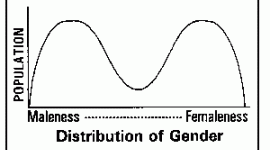Frequently Asked Questions from Non-Intersexed People
Do intersexed people really exist?
Yes... intersexed people, real hermaphrodites, really do exist! The trouble is that most people are only familiar with the two types of mythological hermaphrodite. Hermaphroditus, the merger of Hermes and Aphrodite into one body is a myth and only a myth. Hermaphroditus gives rise to a myth herself about intersexed people - what I call the Two in One myth. Intersexed people are not "both sexes in one" but are a biological uniqueness of their own form.
The second type of mythological hermaphrodite can be seen in some types of pornography. These people are NOT intersexed people. They are women with carefully done prostheses who are making pornography. Some people also seem to be identifying themselves as "intersexed" when perhaps what they mean is "intergendered". Intersex refers to the physical manifestation of genital/genetic/endocrinological differentiation which is different from the cultural norm (refer to the ISNA FAQ for a detailed discussion of biological specifics).
Where are intersexed people?
People who know that intersexed people really do exist may wonder, "If there may be as many as one out of two thousand people affected by some form of intersex condition... where are they all? Why don't we hear of them or see books about their stories?"
The answer is that most intersexed people have a very, very hard time with the personal issues which surround being born intersexed. There is a relatively small group of "out" intersexuals in the world, a number that is steadily growing, but the vast majority of us live with the silence, shame and fear that we learned as children and teens. Other misunderstood minorities have made great strides in being recognized. There are thousands of books written by Gay men and women and even dozens on the subject of transexuality, which is thought to be quite rare in actuality.
The reason may be that most intersexed people have been subjected to very, very powerful family, medical and societal proscriptions about talking about their bodies or medical status. This begins from the very moment of birth for most of us because that is usually when the question is first asked, "Is IT a boy or a girl?" Intersexuals who are subjected to neonatal surgery undergo that early physical trauma and resulting lifelong trauma on many levels. Intersexuals who miss early surgery often grow up alone and confused... and often abused, because of their "in between" status. Surgery as young teens and adults to "correct" their bodies is also traumatic and may not have a satisfactory outcome. It all adds up to one thing: a very strong desire to keep quiet and not tell anyone about being intersexed.
Another factor may be abuse. Some intersexed chidren are abused by peers and family due to their intersexuality. But there is also a sort of institutionalized abuse which takes its toll. The constant dehumanizing exams, case studies, etc. are painful, humiliating and upsetting for a child or young teenager. The result is a desire to never have to talk or deal with the subject ever again.
What term do intersexed people prefer for themselves?
It varies from person to person. You will certainly never offend anyone with the terms intersexed and intersexual. Unfortunately those terms seem to be becoming more prevalent amongst people who are not intersexed, so there is the possibility of confusion. Some people are using what I used to call the "H" word. I never used the term because it symbolized my oppression as a research subject utilized for medical experimentation. I also objected to its mythological origins. We are not creatures from myth or Ovid. Other intersexed people are comfortable calling themselves hermaphrodites. Perhaps the use of the word will help de-mythologize it.
Street terms like "morph" and "morphodite" will not be well received.
What is the difference between "true" and "pseudo" hermaphrodites?
People known in the medical literature as true hermaphrodites have a mixed gonadal structure, ovo-testis, or sometimes one ovary and one testis. Pseudo- hermaphrodites constitute everyone else. As far as intersexuality itself goes... the separation is arbitrary and of academic interest only. Gonadal cellular structure is but one aspect of human biology which affects sex and sexual identity. Early medical writers could have chosen some other form of intersex and labeled it as "true hermaphroditism", such as Androgen Insensitivity Syndrome, but they didn't. The origin of this division is probably more properly in the realm of the social sciences as applied to the medical culture of the time.
What are herms, merms and ferms?
These terms were used by Anne Fausto-Sterling in her 1993 article in _The Sciences_ "The Five Sexes: Why Male and Female are not enough". Herm refers to "true hermaphrodite"; a merm would be a person born intersexed whose karyotype was XY and a ferm is an XX intersexed person. These delineations serve to educate people that sex is not a bipolar dichotomy, but they do not really classify intersexed people themselves in any meaningful way.
What are the other forms of intersexuality?
- Progestin-induced androgenization
Caused by prenatal exposure to exogenous androgens, most commonly progestin. Progestin is a drug which was administered to prevent miscarriage in the 50's and 60's and it is converted to an androgen (virilizing hormone) by the prenatal XX persons metabolism. If the timing is right, the genital anlagen is virilized with effects ranging from enlarged clitoris to the development of a complete phallus and the fusing of the labia. The virilization only occurs prenatally and the endocrinological functionality is unchanged, ie. feminizing puberty occurs due to normally functioning ovaries.
In other words, XX people affected in-utero by virilizing hormones can be born into a continuum of sex phenotype which ranges from "normal female with large clitoris" to "normal male with no testes". It is noteworthy that the use of progestin is not effective in the prevention of miscarriage.
- Congenital Adrenal Hyperplasia
Caused when an anomaly of adrenal function (21-hydroxylase or 11-hydroxylase deficiency) causes the synthesis and excretion an androgen precursor, initiating virilization of a XX person in-utero. Because the virilization originates metabolically, masculinizing effects continue after birth. As in PIA, sex phenotype varies along the same continuum, with the possible added complication of metabolic problems which upset serum sodium balance. The metabolic effects of CAH can be counteracted with cortisone. The scenario for medical intervention for intersex is similar... but CAH people have an increased likelihood of early detection due to metabolic imbalances (Salt Losing Form).
- Androgen Insensitivity/Partial Insensitivity Syndrome
In AIS/PAIS the cellular metabolism of an XY person is such that the cells do not respond to the effects of androgens. Endocrinological function is normal... but the cells ability to bind androgens, due to compromised receptor site metabolism, causes a partial or complete lack of response to virilization. PAIS produces effects similar to CAH or PIA in a neonate... genital ambiguity. With complete AIS a neonate shows no indication that they are intersexed as the external genitalia are completely phenotypically female. Internal female structures do not develop however because Mullerian Inhibiting Hormone is present and prevents the formation of a female genital tract (oviducts, cervix, uterus, part of the vagina).
Another form of AIS is present in individuals with 5-alpha reductase deficieny. During the formation of the male genital tract from the Wolffian duct portion of the genital anlagen, the target tissues are not repondent to testosterone, another form, hydrotestosterone is required at this stage. The required enzyme, 5-alpha reductase, is missing so these people may be assigned and reared as girls. However, since pubertal genital tissue is sensitive to the effects of testosterone... such a child could experience masculinizing puberty and genital growth - assuming that their gonads have not been removed.
- Turner's Syndrome
Turner's Syndrome children are born with an XO karyotype and, in the absence of gonads, develop without any endocrinological influenceing sexual phenotype. What this means however, is that they are phenotypically female and raised as such.
It is significant that these events... the discovery and "management" of our medical conditions occur as neonates, children or teenagers ie. during puberty. Our say in which physical "sex" we are intended to be ranges from very little to none.
Additional FAQS include:
next: Sexual Development - Glossary of Terms
~ all inside intersexuality articles
~ all articles on gender
APA Reference
Staff, H.
(2007, August 9). Frequently Asked Questions from Non-Intersexed People, HealthyPlace. Retrieved
on 2026, January 2 from https://www.healthyplace.com/gender/inside-intersexuality/frequently-asked-questions-from-non-intersexed-people


